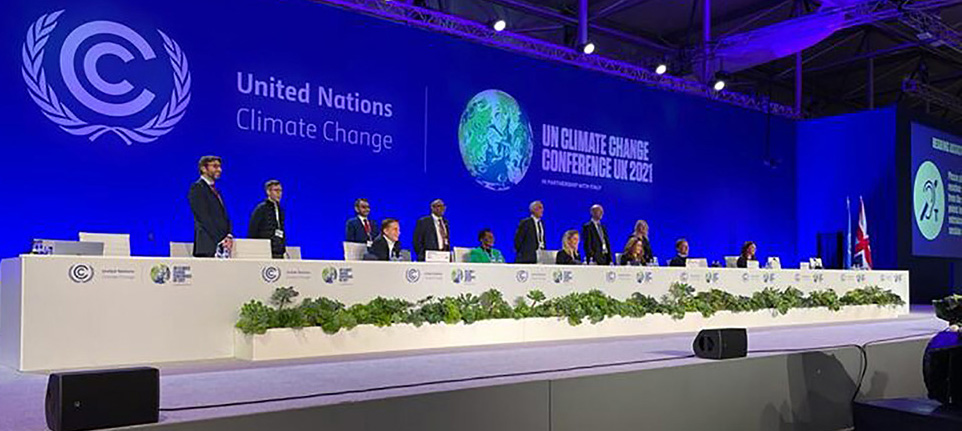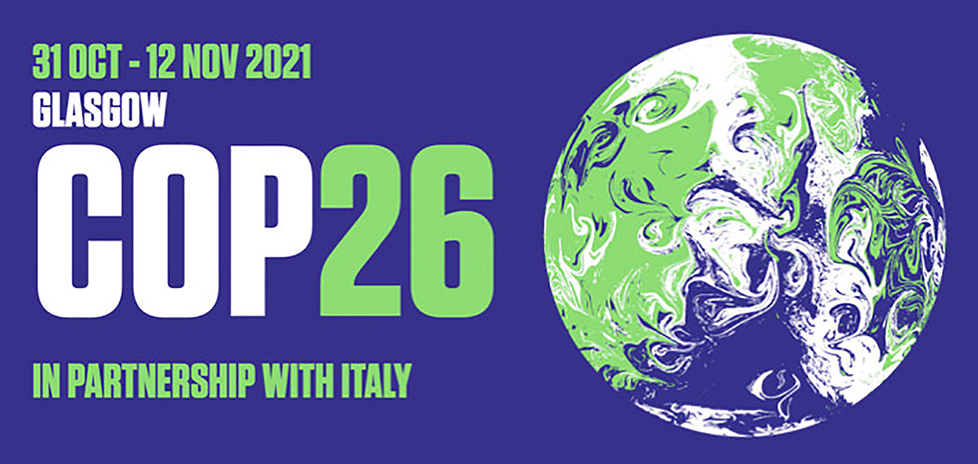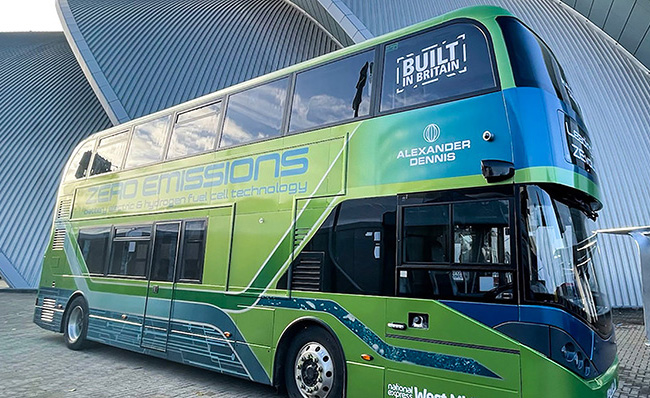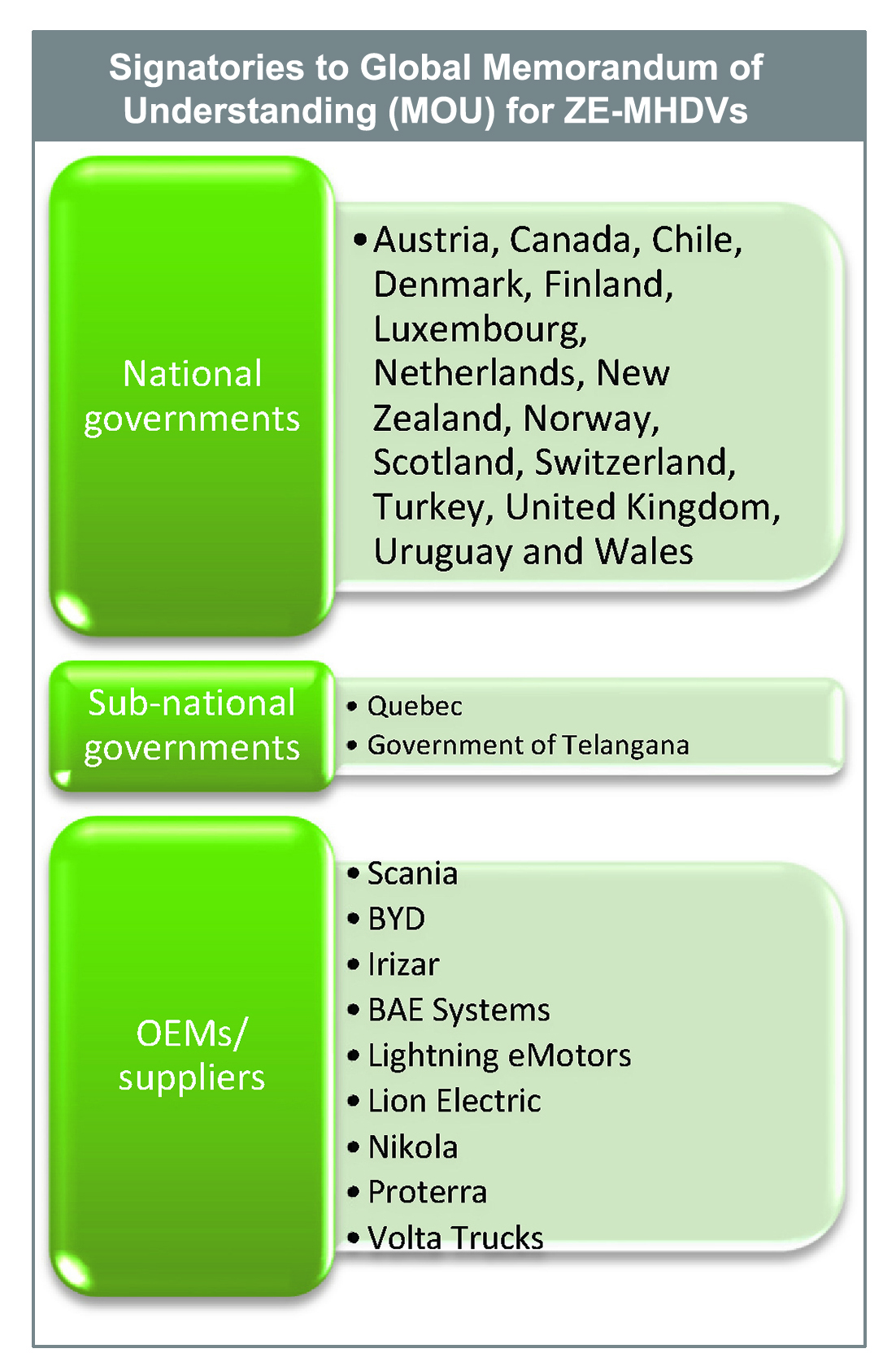
The first-ever global agreement on zero-emission medium and heavy-duty vehicles aims to put net zero-carbon emissions by 2050 within reach by moving toward 100% zero-emission new truck and bus sales by 2040. Dhiyanesh Ravichandran has the details

Of all the automotive-related emission sources, medium and heavy-duty vehicles (MHDVs) have always been the most challenging source to fix or find viable offsetting mechanisms. They account for about 4% of the total vehicle parc on road, but are responsible for about 36% of cumulative fuel consumption and respective emissions, including 73% of on-road nitrogen oxide (NOx) emissions and 60% of particulate matter (PM 2.5) emissions among other harmful pollutants. They are the largest and heaviest vehicles on road and cater to mass transportation or passenger mobility that are essential in nature, and thus add to a disproportionate share of pollution mix.
According to CALSTART’s ‘Drive to Zero’ briefing paper, developed nations will fall short of their net zero carbon emission targets by 2050 if they fail to address the MHDV emissions. There is an urgent need to review their policies and commitments to curb road transport pollution. Many countries are yet to frame some roadmap for curtailing emission from medium and heavy vehicles. Given that the technology shift required to make MHDV segment emission-free requires warrants preparation and investments from all stakeholders, target-setting is the most important step in developing a supportive suite of policies and ecosystem.
Global Commitment
In a historic announcement at the 2021 United Nations Climate Change Conference (COP26) held at Glasgow in November, a first-ever global MoU for zero-emission medium and heavy-duty vehicles (ZE-MHDVs) was signed by 15 countries, along with sub-national governments, private stakeholders and civil society members. Under the MoU, the signatories (listed in Box 1) agreed to work together toward 100% zero-emission new truck and bus sales by 2040 with an interim goal of 30% zero-emission new vehicle sales by 2030. The announcement was made on COP26’s ‘Transport Day’ that also saw a few other significant declarations and global agreements.

These declarations and agreements are framed to drive the global transition to zero-emission transport and are in line to meet the goals of the Paris agreement and limit global warming to 1.5 degrees Celsius. “For the first time we have a unified target, supported by leading governments and industry, for when new trucks and buses should fully transition to zero-emission technologies,” said Dr. Cristiano Facanha, CALSTART’s Global Director. The declaration on ZE-MHDVs was sponsored by CALSTART’s Global Commercial Vehicle ‘Drive to Zero’ programme, in association with the Government of The Netherlands.
It draws significant inspiration from California’s first-of-its-kind Advanced Clean Truck Regulation (ACT) that similarly requires an increasing share of MHDVs that are sold to be zero-emission through 2035. In addition, ‘Drive to Zero’ unveiled its global progress dashboard that brings out ZE-MHDV policy developments taking place across the globe, including the progress made by all signatories. “Nations need to adopt these policies to meet their zero-emission sales targets. We are enabling best practices to be shared and are committing to coordinate actions with the aim of speeding ZE-MHDV uptake and deployment,” said Owen MacDonnell, Associate Project Manager, CALSTART.
Optimism Across the Board
A briefing paper related to the declaration notes that MHDV manufacturers are ramping up their own commitments to zero-emission vehicles in recent times, led by national policies to curb emission from heavy transportation. This alignment between governments and OEMs will help advance and accelerate the deployment of ZE-MHDVs, it adds. The paper finds that only 15 countries have a clear end date for sales of polluting trucks and buses, with almost all of them signing the agreement. Interestingly, sub-national governments like Quebec (Canada) and Government of Telangana (India) are also on the list of signatories.

“For long our medium and heavy-duty vehicles were too difficult to decarbonise. But the technology is improving and costs are dropping. So, now is the time to speed up,” said Steven van Weyenberg, Minister for the Environment of The Netherlands. Austrian Federal Minister for Climate Action Leonore Gewessler called for close international cooperation. “For a timely shift to emission-free vehicles, many players have to work together, transcending national boundaries and industries. With the signing of a global MoU we are very happy to send such a strong signal in this direction,” he commented.
Chile and Uruguay are among the very few developing nations on the list of signatories largely dominated by developed European countries. “In Chile, we are convinced that cleaner and more efficient transport is the key to reaching carbon neutrality. We have been making progress every day to meet them,” said Chile’s Under Secretary of Energy Francisco Lopez. The country’s National Electro Mobility Strategy considers more than 50 concrete actions to set various ambitious goals, including all new light and medium vehicle sales to be zero-emission by 2035.
Private sector participants were also equally optimistic.
Christian Levin, President and CEO, Scania, said, “We will do our part to facilitate scaling of zero-emission solutions faster and more cost-efficiently, not the least through initiatives that spur the build out of charging infrastructure for heavy vehicles.” Scania’s endorsement as a leading manufacturer of conventional vehicles came out as a big push to the declaration. Global logistics firms DHL and EV Cargo affirmed support from the demand side. “DHL believes that collaboration between the private and public sectors will play an important role in accelerating the development of electric vehicles (EVs) in the long haul and heavier-duty road transportation,” said Greg Hewitt, CEO of DHL Express USA.

“The MOU signed represents a highly significant statement of intent in this area and will provide added impetus for companies in our industry to integrate more electric MHDVs into our fleets,” he added. Virginia Alzina, EV Cargo’s Chief Sustainability Officer, stressed on investment in technology as the way forward for the logistics sector. “No one can do this alone. It is crucial that there is a global response to a global problem,” she opined. That said, countries like USA, China, Germany, India and Japan with significantly large heavy-duty fleets than the signatories were conspicuously silent on the question of transitioning to zero-emission.
Inflection Point
On the other side, none of the world’s largest truck and bus makers, barring Scania and BYD, endorsed the agreement. This, indeed, points to the tricky scenario faced by the ZE-MHDV segment at the moment. The transition requires humongous investments in battery and electric component manufacturing and charging infrastructure. Establishing a supportive policy ecosystem is also critical to achieving accelerated action and rapid adoption of innovative, clean technologies by commercial fleets. “Target-setting should be considered a foundational step in developing a supportive suite of policies that will catalyse the major transformation needed in the transport sector,” said Dr. Cristiano Façanha.
He noted that nations must adopt strong regulations and establish targeted and time-bound incentive programs to achieve net-zero carbon emissions by 2050, along with additional infrastructure investments. Nevertheless, the international attention garnered by this non-binding agreement clearly points to the arrival of an inflection point on the path to complete transition to zero-emission heavy vehicles. Further, CALSTART suggests stakeholders to strategically target buses and urban MHDVs with predictable duty cycles to produce significant impact in early markets.
This strategy can kick-start a greater shift, with infrastructure development also scaling up with investments toward these urban vehicles. Powertrain technology developed for these early segments, including that of batteries and motors, will continue to improve as investments flow, and can be transferred to other vehicle applications. The segmentation of vehicle platforms and the targeted deployment over time is commonly known as the ‘Beachhead Strategy’, in which a strategic position is secured and used as a foothold to continue progress forward.
—
CALSTART’s Efforts to Decarbonise Trucks and Buses
CALSTART is a US-based global, non-profit consortium that works with businesses and governments to develop clean, efficient transportation solutions. It’s ‘Drive to Zero’ initiative aims to enable and accelerate the growth of global zero and near-zero-emission commercial vehicles, with the vision that required technology will be commercially viable by 2025 and dominate by 2040 in specific vehicle segments (referred to as ‘beachhead’ segments) and regions such as China, USA, EU, India, Canada, Japan, Mexico and South America. The organisation also has specific segment-wise initiatives and strategies to bring sustainability in heavy transportation.
- Trucks Initiative: Four Activity Strategies
• Helping fleets reduce the risk and cost of purchasing the cleanest trucks and equipment.
• Partnering with industry and public agencies to develop the next generation of heavy-duty near-zero and zero-emissions technologies.
• Validating the performance and business case of clean vehicles to support fleet acceptance.
• Working with industry partners to craft smart regulations, policies and funding for near-zero and zero-emission trucks and equipment. - The Bus Initiative: Four Activity Strategies
• Assisting transit operators to understand, plan and purchase the cleanest bus platforms available.
• Developing the next generation of technologies for public transit and school fleet success, from zero-emission fuel cells to automation-assisted routes and microgrids.
• Providing users and industry with honest assessments of clean bus capabilities and challenges.
• Fighting for fair funding to support transit leadership in operating the cleanest vehicles in their communities.